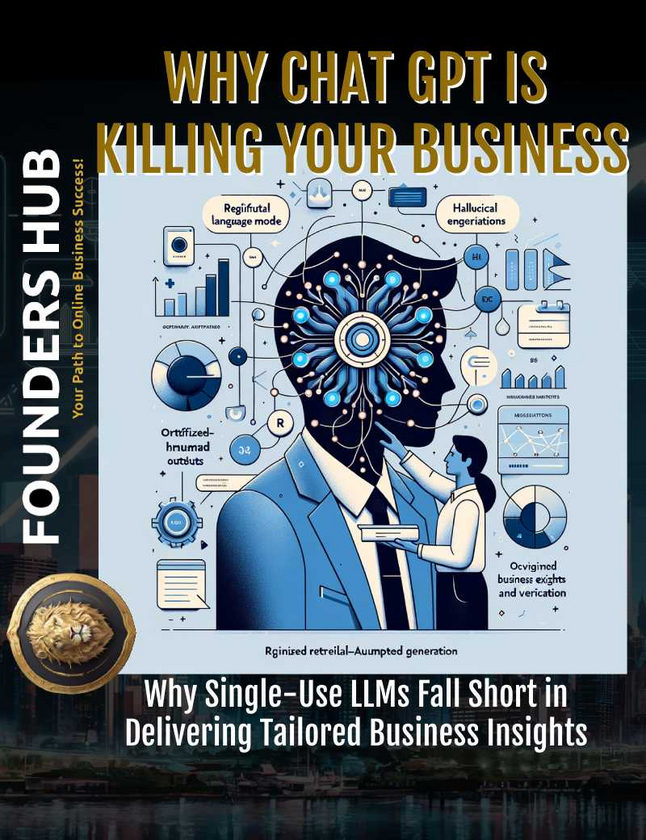𝗖𝗵𝗮𝗽𝘁𝗲𝗿 𝟭. 𝗜𝗻𝘁𝗿𝗼𝗱𝘂𝗰𝘁𝗶𝗼𝗻
1.1. Understanding the Challenges of Starting a Business
• Discusses the excitement and challenges faced by brand-new entrepreneurs.
• Highlight the steep learning curve associated with entrepreneurship.
1.2. The Importance of Avoiding Pitfalls
• Emphasizes the significance of steering clear of common pitfalls.
• Introduce the expert panel from Forbes Coaches Council sharing insights.
𝗖𝗵𝗮𝗽𝘁𝗲𝗿 𝟮. 𝗞𝗻𝗼𝘄𝗶𝗻𝗴 𝗬𝗼𝘂𝗿 𝗕𝘂𝘀𝗶𝗻𝗲𝘀𝘀 𝗣𝘂𝗿𝗽𝗼𝘀𝗲
2.1. The Genesis of a Business
• Explores how businesses often start from a specific need or opportunity.
• Discusses the importance of clearly defining the purpose to avoid confusion.
2.2. The Pitfall: Lack of Clarity
• Addresses the potential confusion that arises without a defined business purpose.
• Provides anecdotes or examples of entrepreneurs who faced this challenge.
𝗖𝗵𝗮𝗽𝘁𝗲𝗿 𝟯. 𝗦𝘁𝗿𝗮𝘁𝗲𝗴𝗶𝗰 𝗕𝘂𝘀𝗶𝗻𝗲𝘀𝘀 𝗗𝗲𝘃𝗲𝗹𝗼𝗽𝗺𝗲𝗻𝘁
3.1. Business Development Before Launch
• Emphasizes the need for prelaunch initiatives and building a referral network.
• Showcases the benefits of having customers from day one.
3.2. The Pitfall: Post-Launch Business Development
• Discusses the risks of waiting until after opening to focus on business development.
• Offers strategies for leveraging industry connections early on.
𝗖𝗵𝗮𝗽𝘁𝗲𝗿 𝟰. 𝗕𝘂𝗶𝗹𝗱𝗶𝗻𝗴 𝗮 𝗖𝗮𝗽𝗮𝗯𝗹𝗲 𝗧𝗲𝗮𝗺
4.1. Organizational Structure in Early Stages
• Explores the common mistake of placing oneself in every organizational role.
• Discusses the challenge of recognizing when to delegate responsibilities.
4.2. The Pitfall: Resistance to Delegation
• Explains the importance of hiring individuals who complement the entrepreneur's skills.
• Provides insights on creating a productive and complementary team environment.
𝗖𝗵𝗮𝗽𝘁𝗲𝗿 𝟱. 𝗖𝗿𝗮𝗳𝘁𝗶𝗻𝗴 𝗮 𝗖𝗹𝗲𝗮𝗿 𝗦𝘁𝗿𝗮𝘁𝗲𝗴𝘆
5.1. Balancing Market Definition and Risk-Taking
• Discusses the delicate balance between defining a market and taking calculated risks.
• Emphasizes the need for a clear strategy with measurable goals.
5.2. The Pitfall: Lack of Direction
• Addresses the risks associated with not having a clear strategic plan.
• Provides examples of businesses that faced challenges due to lack of direction.
𝗖𝗵𝗮𝗽𝘁𝗲𝗿 𝟲. 𝗘𝗻𝘁𝗿𝗲𝗽𝗿𝗲𝗻𝗲𝘂𝗿𝗶𝗮𝗹 𝗪𝗲𝗹𝗹-𝗕𝗲𝗶𝗻𝗴
6.1. The Superpowers and Kryptonite of Entrepreneurs
• Highlights the dedication and commitment of entrepreneurs as strengths.
• Discusses the pitfall of neglecting self-care and personal well-being.
6.2. The Pitfall: Losing Focus on Self
•Provides insights into how entrepreneurs can maintain a balance between work and personal life.
• Shares anecdotes of entrepreneurs who faced burnout due to neglecting self-care.
𝗖𝗵𝗮𝗽𝘁𝗲𝗿 𝟳. 𝗔𝗹𝗶𝗴𝗻𝗶𝗻𝗴 𝗔𝗰𝘁𝗶𝗼𝗻𝘀 𝘄𝗶𝘁𝗵 𝗩𝗮𝗹𝘂𝗲𝘀
7.1. The Trap of Doing What You're Told
• Discusses the common challenge of following instructions without aligning with personal values.
• Introduces the importance of questioning decisions and implementing structures that align with values.
7.2. The Pitfall: Building a Business You Hate
• Explores the consequences of building a business that goes against personal values.
• Provides actionable steps to align business decisions with personal values.
𝗖𝗵𝗮𝗽𝘁𝗲𝗿 𝟴. 𝗘𝗳𝗳𝗲𝗰𝘁𝗶𝘃𝗲 𝗧𝗶𝗺𝗲 𝗠𝗮𝗻𝗮𝗴𝗲𝗺𝗲𝗻𝘁
8.1. The Pitfall: Trying to Do Too Much
• Discusses the drawbacks of multitasking and undertaking too many initiatives.
• Emphasizes the importance of a cohesive target plan and focused strategies.
8.2. Strategic Planning for Daily Tasks
• Provides practical advice on structuring daily tasks for optimal time management.
• Discusses the benefits of planning and prioritizing tasks in advance.
𝗖𝗵𝗮𝗽𝘁𝗲𝗿 𝟵. 𝗘𝗺𝗯𝗿𝗮𝗰𝗶𝗻𝗴 𝗧𝗲𝗰𝗵𝗻𝗼𝗹𝗼𝗴𝘆
9.1. The Role of Technology in Business Growth
• Highlights the interconnected nature of today's business environment.
• Discusses the importance of evaluating technology for business growth.
9.2. The Pitfall: Neglecting Technology
• Addresses the risks of ignoring the role of technology in business operations.
• Provides examples of businesses that flourished by embracing technology.
𝗖𝗵𝗮𝗽𝘁𝗲𝗿 𝟭𝟬. 𝗚𝗼𝗮𝗹-𝗢𝗿𝗶𝗲𝗻𝘁𝗲𝗱 𝗣𝗹𝗮𝗻𝗻𝗶𝗻𝗴
10.1. The Significance of Clear Business Goals - Emphasize the necessity of a well-defined business plan and goals. - Discuss the risks of losing focus without clear objectives.
10.2. The Pitfall: Vision Without Execution - Explore the consequences of not translating vision into actionable plans. - Provide tips on aligning goals with actionable steps.
𝗖𝗵𝗮𝗽𝘁𝗲𝗿 𝟭𝟭. 𝗦𝘁𝗿𝘂𝗰𝘁𝘂𝗿𝗲𝗱 𝗧𝗶𝗺𝗲 𝗠𝗮𝗻𝗮𝗴𝗲𝗺𝗲𝗻𝘁
11.1. The Illusion of Abundant Time - Discuss the common misconception of having ample time as a new business owner. - Highlight the challenges of time management for entrepreneurs.
11.2. The Pitfall: Unstructured Days - Address the importance of planning and structuring daily tasks. - Provide insights on making the best use of available time.
𝗖𝗵𝗮𝗽𝘁𝗲𝗿 𝟭𝟮. 𝗦𝘁𝗿𝗮𝘁𝗲𝗴𝗶𝗰 𝗙𝗼𝗰𝘂𝘀 𝗢𝘃𝗲𝗿 𝗕𝘂𝘀𝘆𝘄𝗼𝗿𝗸
12.1. Distinguishing Between Busy and Strategic - Explore the difference between being busy and being strategic in business. - Discuss the impact of strategic thinking on long-term success.
12.2. The Pitfall: Operational Over Strategic - Address the risks of prioritizing operational tasks over strategic planning. - Provide guidance on balancing operational efficiency with strategic vision.
𝗖𝗵𝗮𝗽𝘁𝗲𝗿 𝟭𝟯. 𝗩𝗮𝗹𝗶𝗱𝗮𝘁𝗶𝗻𝗴 𝗜𝗱𝗲𝗮𝘀 𝗧𝗵𝗿𝗼𝘂𝗴𝗵 𝗦𝗮𝗹𝗲𝘀
13.1. The Role of Sales in Business Validation - Emphasize the importance of validating business ideas through sales. - Discuss how sales can be a powerful tool for entrepreneurs.
13.2. The Pitfall: Developing Without Sales Validation - Explore the risks of investing time and resources without validating ideas through sales. - Provide examples of businesses that failed to validate their offers.
𝗖𝗵𝗮𝗽𝘁𝗲𝗿 𝟭𝟰. 𝗙𝗶𝗻𝗮𝗻𝗰𝗶𝗮𝗹 𝗟𝗶𝘁𝗲𝗿𝗮𝗰𝘆 𝗳𝗼𝗿 𝗘𝗻𝘁𝗿𝗲𝗽𝗿𝗲𝗻𝗲𝘂𝗿𝘀
14.1. Knowing Your Numbers - Discuss the importance of understanding financial metrics for business success. - Highlight the consequences of not being fully aware of the financial aspects of the business.
14.2. The Pitfall: Flawed Financial Planning - Share personal experiences or anecdotes of entrepreneurs who faced challenges due to financial ignorance. - Provide tips on maintaining accurate financial records and planning.
𝗖𝗵𝗮𝗽𝘁𝗲𝗿 𝟭𝟱. 𝗦𝘁𝗿𝗮𝘁𝗲𝗴𝗶𝗰 𝗙𝗼𝗿𝗲𝗰𝗮𝘀𝘁𝗶𝗻𝗴
15.1. The Importance of Knowing Your Runway - Discuss the significance of short-term and long-term financial projections. - Address the potential consequences of running out of funds.
15.2. The Pitfall: Underestimating Cash Flow - Explore the risks associated with underestimating the timing of implementation and success plans. - Provide actionable steps for understanding and managing cash flow effectively.
𝗖𝗵𝗮𝗽𝘁𝗲𝗿 𝟭𝟲. 𝗕𝘂𝗶𝗹𝗱𝗶𝗻𝗴 𝗮 𝗦𝘂𝗽𝗽𝗼𝗿𝘁 𝗡𝗲𝘁𝘄𝗼𝗿𝗸
16.1. The Need for a Sounding Board - Emphasize the importance of having a support network for entrepreneurs. - Discuss how sharing thoughts and ideas can contribute to well-thought-out plans.
16.2. The Pitfall: Isolation in Decision-Making - Address the challenges of making decisions in isolation. - Provide guidance on building a network and seeking support.
𝗖𝗵𝗮𝗽𝘁𝗲𝗿 𝟭𝟳. 𝗚𝗿𝗮𝗱𝘂𝗮𝗹 𝗕𝘂𝘀𝗶𝗻𝗲𝘀𝘀 𝗘𝘅𝗽𝗮𝗻𝘀𝗶𝗼𝗻
17.1. Sustainable Growth Strategies - Discuss the value of doing fewer things superbly versus expanding too quickly. - Highlight the importance of stabilizing before addressing a broader market.
17.2. The Pitfall: Premature Expansion - Explore the risks of trying to address the entire market before establishing stability. - Provide examples of businesses that faced challenges due to premature expansion.
𝗖𝗵𝗮𝗽𝘁𝗲𝗿 𝟭𝟴. 𝗖𝗼𝗻𝗰𝗹𝘂𝘀𝗶𝗼𝗻
• Summarizes key takeaways from each chapter.
• Reiterates the importance of avoiding pitfalls for new entrepreneurs.
• Encourages a proactive approach to business challenges.
𝗖𝗵𝗮𝗽𝘁𝗲𝗿 𝟭. 𝗜𝗻𝘁𝗿𝗼𝗱𝘂𝗰𝘁𝗶𝗼𝗻
1.1. Navigating the Entrepreneurial Landscape.
Embarking on the journey of entrepreneurship is akin to setting sail on uncharted waters—a thrilling yet challenging expedition. In this dynamic realm, the allure of creating something novel is met with the stark reality of an intricate learning curve. Understanding the challenges that brand-new entrepreneurs face is paramount to navigating this unexplored terrain successfully.
Excitement and Challenges of Entrepreneurship
Starting a business is a venture fueled by passion, innovation, and the desire to carve a niche in the market. Entrepreneurs are driven by the prospect of transforming their ideas into thriving enterprises. However, beneath the surface of excitement lies a multifaceted landscape fraught with challenges. From establishing a viable business model to addressing market demands, the hurdles are as diverse as the entrepreneurial spirit itself.
The Steep Learning Curve
Central to the entrepreneurial narrative is the realization that success demands more than just a groundbreaking idea. The journey involves mastering the art of strategic planning, team leadership, and adapting to an ever-evolving market. The steep learning curve is a formidable adversary that necessitates constant adaptation and learning.
1.2. The Pitfalls That Lurk
In the quest for success, avoiding common pitfalls becomes a strategic imperative. Aspiring entrepreneurs are not alone in this endeavor; the guidance of the Forbes Coaches Council, a consortium of seasoned business coaches, illuminates the path forward.
Significance of Pitfall Avoidance
The importance of steering clear of pitfalls cannot be overstated. Each misstep, if not anticipated and avoided, can have cascading effects on the trajectory of a new venture. Recognizing the potential challenges early on allows entrepreneurs to fortify their foundations and position themselves for sustainable growth.
Insights from Forbes Coaches Council
An invaluable resource on this journey is the collective wisdom of the Forbes Coaches Council. Comprising experienced professionals who have mentored aspiring business owners, the council provides insights into the most prevalent pitfalls observed in the entrepreneurial landscape. Their expertise serves as a beacon, guiding entrepreneurs away from common traps and towards the path of prosperity.
In the chapters that follow, we delve into specific aspects of entrepreneurship, dissecting challenges, and presenting actionable strategies to overcome them. The insights shared by the Forbes Coaches Council serve as a compass, steering entrepreneurs away from potential pitfalls and towards the pinnacle of success in the competitive business landscape.
𝗖𝗵𝗮𝗽𝘁𝗲𝗿 𝟮. 𝗞𝗻𝗼𝘄𝗶𝗻𝗴 𝗬𝗼𝘂𝗿 𝗕𝘂𝘀𝗶𝗻𝗲𝘀𝘀 𝗣𝘂𝗿𝗽𝗼𝘀𝗲
2.1. Unveiling the Essence of Entrepreneurial Genesis
In the dynamic landscape of entrepreneurship, the genesis of a business is often rooted in a keen understanding of a specific need or untapped opportunity. This chapter delves into the intricate process of identifying these catalysts and harnessing them to shape a distinct business purpose.
Exploration of Entrepreneurial Roots
Every business has a story, an origin that goes beyond the mere pursuit of profit. Entrepreneurs, as modern-day visionaries, are compelled by a deeper drive to address a gap in the market or provide a unique solution. Understanding how businesses evolve from an idea to a purpose-driven entity is essential for entrepreneurs to carve their niche.
Clarity as a Strategic Imperative
The journey from conception to clarity is not merely an option; it is a strategic imperative. Entrepreneurs must meticulously define their business purpose to avoid the pitfalls of ambiguity. Lack of clarity can lead to confusion among stakeholders, hindering progress and impeding the realization of the envisioned goals.
2.2. Navigating the Pitfall: Lack of Clarity
Untangling the Web of Confusion
In the absence of a well-defined business purpose, entrepreneurs risk navigating a labyrinth of uncertainty. This section addresses the potential pitfalls associated with a lack of clarity and provides actionable insights to unravel the web of confusion.
Anecdotes of Clarity Challenges
Real-world examples illustrate the perils faced by entrepreneurs who ventured into the business realm without a crystal-clear purpose. These anecdotes serve as cautionary tales, emphasizing the tangible impact that a vague or undefined business purpose can have on the trajectory of a new venture.
Strategies for Purposeful Definition
To mitigate the risks posed by a lack of clarity, entrepreneurs can adopt strategic approaches to define their business purpose. This involves honing in on core values, aligning offerings with market demands, and crafting a mission that resonates with both internal teams and external stakeholders.
In the chapters that follow, we continue our exploration into the multifaceted facets of entrepreneurship, unraveling challenges, and presenting diverse perspectives. The journey towards a purpose-driven business requires a nuanced understanding of the genesis and a relentless commitment to clarity—an odyssey we navigate together at the founders hub.
𝗖𝗵𝗮𝗽𝘁𝗲𝗿 𝟯. 𝗦𝘁𝗿𝗮𝘁𝗲𝗴𝗶𝗰 𝗕𝘂𝘀𝗶𝗻𝗲𝘀𝘀 𝗗𝗲𝘃𝗲𝗹𝗼𝗽𝗺𝗲𝗻𝘁
3.1. Crafting Success Before Launch
In the intricate dance of entrepreneurship, the prelaunch phase holds the power to shape the trajectory of a new venture. This chapter unfolds the strategic dimensions of business development before the grand opening, emphasizing the pivotal role it plays in fostering success.
Embracing Prelaunch Initiatives
Entrepreneurs are akin to architects laying the foundation of a skyscraper. The necessity of prelaunch initiatives cannot be overstated. This section elucidates the significance of meticulously planning and executing initiatives that set the stage for a thriving business.
• Building a Referral Network: Networking isn't just a buzzword; it's a strategic move. Entrepreneurs at the founders hub recognize the power of connections before the curtains rise. Building a robust referral network becomes a cornerstone, unlocking doors to potential customers and collaborators.
• Customers from Day One: The modern business landscape demands a proactive approach. This segment underscores the benefits of securing customers from the inception. Early adopters not only validate the business concept but also provide a foundation for future growth.
3.2. Navigating the Post-Launch Landscape
Strategies for Post-Launch Business Development
The allure of post-launch endeavors can be tempting, but entrepreneurs at the founders hub understand the risks associated with delayed business development. This part of the chapter presents insightful strategies for navigating the post-launch landscape.
• Risk Mitigation Through Early Focus: Waiting until after the grand opening to focus on business development is akin to steering a ship without a compass. Entrepreneurs mitigate risks by directing attention to business development from the outset.
• Leveraging Industry Connections: The business realm thrives on relationships. Waiting until post-launch to cultivate industry connections is a missed opportunity. Successful entrepreneurs strategically leverage industry ties early on, unlocking a myriad of growth possibilities.
In the subsequent chapters, our exploration continues, delving into the nuances of organizational dynamics and strategic planning. The journey towards entrepreneurial success demands a holistic understanding, and at the founders hub, we navigate these waters with a compass calibrated for strategic business development.
𝗖𝗵𝗮𝗽𝘁𝗲𝗿 𝟰. 𝗕𝘂𝗶𝗹𝗱𝗶𝗻𝗴 𝗮 𝗖𝗮𝗽𝗮𝗯𝗹𝗲 𝗧𝗲𝗮𝗺
4.1. Mastering Organizational Dynamics
Creating a thriving business extends beyond the visionary entrepreneur—it requires a harmonious team. In this chapter, we delve into the intricate dance of organizational structure during the early stages, uncovering the common mistake of overextending oneself and the challenge of effective delegation.
Navigating the Organizational Maze
The entrepreneurial journey often begins with a solo act, but the crescendo of success is achieved through a symphony of collaboration. This section dissects the pitfalls of attempting to wear every hat in the organization and the necessity of recognizing when to pass the baton.
• Soloist Syndrome: Entrepreneurs at the founders hub understand the allure of doing it all. However, this segment posits that the soloist syndrome, the inclination to handle every role, can stifle growth. We explore the delicate balance between hands-on involvement and strategic delegation.
• Recognizing the Delegation Threshold: Building a capable team starts with acknowledging individual limitations. We explore the challenge of recognizing when to delegate responsibilities, ensuring tasks are entrusted to those with complementary skills. The key lies in creating an organizational structure that fosters efficiency without compromising quality.
4.2. Harmonizing Team Dynamics
Complementary Team Building
Entrepreneurial success is not a solo act but a collaborative performance. This section unfolds the pitfalls associated with resistance to delegation and provides insights into crafting a team environment where each member's strengths shine.
• The Pitfall of Resistance: Resistance to delegation can impede progress. Entrepreneurs often grapple with letting go, fearing a loss of control. We demystify this pitfall, emphasizing the importance of building a team open to collaboration and innovation.
• Productive Team Synergy: The founders hub champions the idea that a team is more than the sum of its parts. We explore the intricacies of hiring individuals who complement the entrepreneur's skills, creating a tapestry of diverse strengths. The chapter provides actionable insights into fostering a collaborative and productive team environment.
In the subsequent chapters, our exploration continues, moving from team dynamics to the realm of strategic planning. Building a capable team is a foundational step, and at the founders hub, we navigate this journey with an unwavering commitment to organizational excellence.
𝗖𝗵𝗮𝗽𝘁𝗲𝗿 𝟱. 𝗖𝗿𝗮𝗳𝘁𝗶𝗻𝗴 𝗮 𝗖𝗹𝗲𝗮𝗿 𝗦𝘁𝗿𝗮𝘁𝗲𝗴𝘆
5.1. Navigating the Strategy Landscape
In the dynamic realm of entrepreneurship, strategic clarity emerges as the compass guiding ventures through uncharted territories. At the founders hub, we explore the intricate art of balancing market definition and risk-taking to carve a trajectory toward sustainable success.
Defining Your Market Terrain
Understanding the landscape is paramount. This section delves into the delicate equilibrium between defining a market and taking calculated risks.
• Precision in Market Definition: Crafting a clear strategy demands a nuanced comprehension of the market. We dissect the importance of precisely defining the target audience, tailoring products or services to meet specific needs. This targeted approach enhances the effectiveness of business strategies.
• Calculated Risks as Catalysts: The founders hub celebrates the entrepreneurial spirit that embraces risks as catalysts for innovation. This segment asserts that calculated risks are not merely leaps of faith but informed decisions integral to strategic success. Through anecdotes and insights, we illustrate how risk-taking can be a transformative force in business evolution.
5.2. The Perils of Directionless Endeavors
Mitigating Risks Through Strategic Clarity
In this segment, we unravel the risks associated with embarking on the entrepreneurial journey without a clear strategic plan.
• Navigating the Business Fog: Lack of direction can plunge a promising venture into obscurity. We navigate through the metaphorical fog that shrouds businesses without a clear strategic plan. Through real-world examples, we illuminate the pitfalls of ambiguity and the potential consequences of deviating from a predefined path.
• Learning from Missteps: Drawing lessons from businesses that faced challenges due to lack of direction, this chapter advocates for a proactive approach to strategic planning. Entrepreneurs at the founders hub understand that every misstep is an opportunity for course correction.
As the strategic journey unfolds, the next chapter beckons, inviting entrepreneurs to reflect on the delicate interplay of entrepreneurial well-being. At the founders hub, strategic clarity is not just a goal; it's a navigational tool for entrepreneurs charting their course in the ever-evolving business landscape.
𝗖𝗵𝗮𝗽𝘁𝗲𝗿 𝟲. 𝗘𝗻𝘁𝗿𝗲𝗽𝗿𝗲𝗻𝗲𝘂𝗿𝗶𝗮𝗹 𝗪𝗲𝗹𝗹-𝗕𝗲𝗶𝗻𝗴
6.1. The Superpowers and Kryptonite of Entrepreneurs
Entrepreneurs, akin to superheroes, exhibit remarkable dedication and commitment, propelling their ventures forward. At the founders hub, we shed light on the superpowers that drive entrepreneurial success.
Dedication as a Driving Force
Entrepreneurship demands unwavering dedication. In this section, we delve into the tenacity that propels entrepreneurs to overcome challenges. Drawing parallels to superhero resilience, we explore how dedication serves as a foundational superpower, fueling the entrepreneurial journey.
• Passion as a Catalyst: Passion, the heartbeat of dedication, transforms challenges into opportunities. We emphasize the role of passion in sustaining momentum during trying times and fueling the innovation necessary for long-term success.
• Commitment to Vision: Entrepreneurs navigate uncertainty with a clear vision. This chapter articulates how a steadfast commitment to the entrepreneurial vision becomes a guiding beacon, ensuring consistent progress amidst inevitable obstacles.
6.2. The Pitfall: Losing Focus on Self
Balancing Act: Work and Personal Well-Being
While dedication fuels success, entrepreneurs must navigate the pitfall of neglecting self-care. This section uncovers the kryptonite that can erode the very foundations of entrepreneurial superpowers.
• Recognizing Burnout Signs: Entrepreneurs often tread perilously close to burnout. We explore the signs and symptoms, providing insights into recognizing when dedication transforms into a detriment to personal well-being.
• Strategies for Balance: Through real-world anecdotes, we share practical strategies for entrepreneurs to maintain equilibrium. From effective time management to fostering a supportive work environment, we explore ways to prevent burnout while nurturing business growth.
As entrepreneurs harness their superpowers, the next chapter beckons—a profound exploration of aligning actions with personal values. At the founders hub, the well-being of entrepreneurs is not just a consideration; it's an essential element in the recipe for sustained success.
𝗖𝗵𝗮𝗽𝘁𝗲𝗿 𝟳. 𝗔𝗹𝗶𝗴𝗻𝗶𝗻𝗴 𝗔𝗰𝘁𝗶𝗼𝗻𝘀 𝘄𝗶𝘁𝗵 𝗩𝗮𝗹𝘂𝗲𝘀
7.1. The Trap of Doing What You're Told
In the dynamic realm of entrepreneurship, aligning actions with personal values emerges as a critical compass for success. At the founders hub, we unravel the intricate dance between adherence to instructions and staying true to one's values.
Navigating Instruction Adherence
Entrepreneurs often find themselves caught in the trap of doing what they're told, driven by external expectations or market trends. In this section, we explore the nuances of this common challenge:
• External Pressures: We delve into the external forces that compel entrepreneurs to conform, whether it be market trends, investor expectations, or industry standards.
• Short-Term Gains vs. Long-Term Values: An analysis of the tension between achieving short-term gains by conforming and the potential erosion of long-term values. We present perspectives on finding a balance that ensures both immediate success and sustained integrity.
7.2. The Pitfall: Building a Business You Hate
Consequences of Misalignment
Building a business that contradicts personal values can lead to profound consequences. In this segment, we explore the intricacies of this pitfall:
• Strained Motivation: Entrepreneurs who build ventures misaligned with their values often face a decline in motivation. We discuss the implications of running a business that lacks personal resonance.
• Impact on Decision-Making: The chapter sheds light on how misalignment can seep into decision-making processes, potentially compromising the long-term viability of the business.
Actionable Steps Toward Alignment
Recognizing the pitfall is the first step. We provide actionable insights to help entrepreneurs build businesses that harmonize with their values:
• Value-Centric Decision Framework: Introducing a decision-making framework centered on personal values. We explore methods to embed values into strategic choices, ensuring alignment at every juncture.
• Structures for Alignment: Practical steps to implement structures that foster alignment, from company culture to mission statements. We emphasize the importance of creating an ecosystem that reflects the entrepreneur's core values.
As entrepreneurs navigate the intricate landscape of aligning actions with values, the upcoming chapter awaits—an exploration of effective time management. At the founders hub, we champion the fusion of values and business strategy, fostering ventures that not only succeed but also resonate authentically with their creators.
𝗖𝗵𝗮𝗽𝘁𝗲𝗿 𝟴. 𝗘𝗳𝗳𝗲𝗰𝘁𝗶𝘃𝗲 𝗧𝗶𝗺𝗲 𝗠𝗮𝗻𝗮𝗴𝗲𝗺𝗲𝗻𝘁
8.1. The Pitfall: Trying to Do Too Much
In the pulsating world of entrepreneurship, effective time management stands as a linchpin for success. At the founders hub, we unravel the intricate dance between ambitious multitasking and the necessity for focused strategies.
Multitasking Drawbacks
Entrepreneurs often fall prey to the allure of multitasking, believing it to be a shortcut to productivity. In this section, we explore the drawbacks of trying to do too much:
• Diminished Focus: We delve into the cognitive science behind multitasking, revealing how it diminishes the depth of focus and hampers overall productivity.
• Quality vs. Quantity: An exploration of the trade-off between quantity of tasks and the quality of execution. We present perspectives on striking a balance that ensures both productivity and excellence.
Cohesive Target Plans
Amid the pitfalls lies the remedy. We emphasize the importance of a cohesive target plan to counter the challenges of multitasking:
• Strategic Prioritization: Guidance on strategically prioritizing tasks based on their impact on overarching business goals. We discuss methods to identify high-impact activities and allocate time accordingly.
• Focused Execution: Insight into the benefits of focused execution, providing tangible examples of entrepreneurs who achieved remarkable success by narrowing their focus.
8.2. Strategic Planning for Daily Tasks
The Art of Daily Planning
Entrepreneurial success often hinges on the ability to navigate daily tasks strategically. This segment explores the art of strategic planning for daily tasks:
• Time Blocking Techniques: Introduction to time blocking as an effective method for structuring the day. We provide actionable steps to implement time blocking techniques for optimal productivity.
• Prioritization Frameworks: Discussion on various prioritization frameworks, guiding entrepreneurs to choose methodologies that align with their unique work styles.
Benefits of Planning
As entrepreneurs navigate the challenges of multitasking, strategic planning emerges as a beacon of efficiency. We discuss the benefits:
• Reduced Stress: Strategic planning contributes to a more controlled work environment, mitigating stress and enhancing overall well-being.
• Enhanced Decision-Making: The chapter sheds light on how strategic planning facilitates better decision-making by providing a clear roadmap for daily activities.
At the founders hub, we advocate for a shift from the frenzy of trying to do too much to a strategic, well-planned approach. As the next chapter beckons, entrepreneurs will explore the crucial role of embracing technology in fostering business growth. Stay attuned to the evolution of effective entrepreneurial strategies.
𝗖𝗵𝗮𝗽𝘁𝗲𝗿 𝟵. 𝗘𝗺𝗯𝗿𝗮𝗰𝗶𝗻𝗴 𝗧𝗲𝗰𝗵𝗻𝗼𝗹𝗼𝗴𝘆
9.1. The Role of Technology in Business Growth
In the dynamic landscape of entrepreneurship, embracing technology is not merely a choice but a strategic imperative. At the founders hub, we delve into the profound impact of technology on propelling business growth.
Interconnected Business Environment
In this section, we explore the interconnected nature of today's business environment and how technology serves as its linchpin:
• Global Connectivity: Discussing how technology facilitates global connectivity, enabling businesses to transcend geographical boundaries and tap into diverse markets.
• Operational Efficiency: An examination of how technological tools enhance operational efficiency, streamlining processes and reducing manual workload.
Evaluating Technology for Growth
The chapter unfolds with a critical discussion on the importance of evaluating technology for sustainable business growth:
• Scalability: Delving into the scalability aspect of technology solutions, emphasizing the need for systems that can evolve with the business.
• Adaptability to Industry Trends: Exploring the role of technology in adapting to and capitalizing on evolving industry trends, ensuring businesses stay competitive.
9.2. The Pitfall: Neglecting Technology
Risks of Technological Neglect
While extolling the virtues of technology, we address the inherent risks associated with neglecting its role in business operations:
• Competitive Disadvantage: Discussing how businesses that neglect technology risk falling behind competitors who leverage the latest tools and innovations.
• Inefficiency and Redundancy: Highlighting the dangers of inefficiency and redundancy in operations when technology is overlooked, leading to wasted resources.
Success Stories of Tech Integration
To illuminate the transformative power of technology, we present real-world examples of businesses that flourished by wholeheartedly embracing technological advancements.
• Agile Startups: Examining how startups agilely leverage technology to disrupt industries and gain a competitive edge.
• Traditional Businesses Embracing Change: Illustrating how even traditional businesses thrive when they integrate technology into their core operations.
At the founders hub, we advocate not only for the integration of technology into business strategies but also for a proactive approach in staying abreast of technological advancements. As the entrepreneurial journey progresses, the forthcoming chapter will unravel the intricacies of goal-oriented planning. Stay tuned for insights into aligning visionary goals with actionable plans for business success.
𝗖𝗵𝗮𝗽𝘁𝗲𝗿 𝟭𝟬. 𝗚𝗼𝗮𝗹-𝗢𝗿𝗶𝗲𝗻𝘁𝗲𝗱 𝗣𝗹𝗮𝗻𝗻𝗶𝗻𝗴
10.1. The Significance of Clear Business Goals
In the entrepreneurial landscape, navigating the intricate journey of business ownership demands a compass — a set of clear and well-defined goals. At the founders hub, we delve into the critical importance of goal-oriented planning for sustainable success.
Necessity of a Well-Defined Business Plan
In this section, we underscore the necessity of crafting a well-defined business plan and setting tangible goals:
• Strategic Roadmap: Discussing how a business plan serves as a strategic roadmap, guiding entrepreneurs through challenges and opportunities.
• Focus and Direction: Emphasizing how clear goals provide focus and direction, preventing businesses from drifting into ambiguity.
Risks of Losing Focus
The chapter unfolds with an exploration of the risks associated with losing focus and veering away from established objectives:
• Opportunity Costs: Discussing the opportunity costs of not aligning daily activities with overarching business goals.
• Competitive Disadvantage: Highlighting how businesses may fall behind competitors when goals are unclear or constantly changing.
10.2. The Pitfall: Vision Without Execution
Consequences of Unrealized Vision
While extolling the virtues of visionary thinking, we address the potential pitfalls of having a vision without effective execution:
• Stagnation and Frustration: Discussing how a compelling vision, unsupported by actionable plans, can lead to stagnation and frustration.
• Lack of Accountability: Highlighting the role of accountability in bridging the gap between vision and execution, preventing a business from floundering.
Tips on Aligning Goals with Actionable Steps
To equip entrepreneurs with actionable insights, this section provides practical tips on ensuring goals seamlessly align with actionable steps:
• SMART Criteria: Discussing the SMART criteria — Specific, Measurable, Achievable, Relevant, and Time-bound — as a framework for goal-setting.
• Periodic Review and Adjustment: Emphasizing the importance of periodic review and adjustment of goals in response to evolving business landscapes.
At the founders hub, we advocate not only for the articulation of ambitious business goals but also for their translation into tangible actions. As the entrepreneurial journey progresses, the forthcoming chapter will unravel the complexities of structured time management. Stay tuned for insights into navigating the illusion of abundant time and harnessing it effectively for business growth.
𝗖𝗵𝗮𝗽𝘁𝗲𝗿 𝟭𝟭. 𝗦𝘁𝗿𝘂𝗰𝘁𝘂𝗿𝗲𝗱 𝗧𝗶𝗺𝗲 𝗠𝗮𝗻𝗮𝗴𝗲𝗺𝗲𝗻𝘁
11.1. The Illusion of Abundant Time
In the dynamic world of entrepreneurship, the illusion of having ample time can be a deceptive pitfall. At the founders hub, we dissect the common misconception surrounding time and its impact on the entrepreneurial journey.
Challenges of Time Management
Entrepreneurs often enter the business realm believing time is an abundant resource. This section discusses:
• Overcommitment: Delving into the challenges of overcommitting to tasks and initiatives, leading to time-related stress.
• Priority Dilemmas: Addressing the dilemma of prioritizing tasks and the consequences of misjudging their urgency.
Time Management for Entrepreneurs
To navigate the challenges, this section provides insights into effective time management tailored for entrepreneurs:
• Focus on Priorities: Emphasizing the importance of identifying and focusing on high-priority tasks that align with business goals.
• Time Blocking Techniques: Introducing time-blocking techniques to allocate specific periods for different types of tasks, promoting efficiency.
11.2. The Pitfall: Unstructured Days
Importance of Planning
This segment delves into the risks associated with unstructured days and the importance of meticulous planning:
• Productivity Impact: Discussing how unstructured days can lead to decreased productivity and hinder progress.
• Strategic Allocation: Highlighting the strategic allocation of time for essential tasks versus non-essential activities.
Making the Best Use of Available Time
The chapter concludes with actionable insights on making the best use of the available time:
• Prioritization Strategies: Offering strategies for effective prioritization, ensuring entrepreneurs invest time where it matters most.
• Flexibility Within Structure: Advocating for flexibility within a structured plan, allowing for adaptability to unforeseen challenges.
As entrepreneurs embrace the structured approach to time management, the subsequent chapter will unravel the nuances of distinguishing between busywork and strategic endeavors. Stay tuned for an exploration into the impact of strategic thinking on long-term entrepreneurial success.
𝗖𝗵𝗮𝗽𝘁𝗲𝗿 𝟭𝟮. 𝗦𝘁𝗿𝗮𝘁𝗲𝗴𝗶𝗰 𝗙𝗼𝗰𝘂𝘀 𝗢𝘃𝗲𝗿 𝗕𝘂𝘀𝘆𝘄𝗼𝗿𝗸
12.1. Distinguishing Between Busy and Strategic
In the realm of entrepreneurship, the ability to distinguish between being busy and being strategic is a pivotal skill. At the founders hub, we delve into the nuances of strategic focus and its transformative impact on long-term business success.
Busywork vs. Strategic Endeavors
This section dissects the fundamental differences between mere busyness and strategic thinking:
• Activity vs. Productivity: Discussing how being busy with activities doesn't always translate to productive outcomes.
• Short-Term vs. Long-Term Vision: Emphasizing the importance of aligning daily tasks with long-term business objectives.
Impact of Strategic Thinking
Entrepreneurs are encouraged to cultivate strategic thinking for lasting success:
• Innovation and Adaptability: Exploring how strategic thinking fosters innovation and the ability to adapt to evolving market landscapes.
• Risk Mitigation: Discussing how strategic planning serves as a tool for mitigating risks and navigating uncertainties.
12.2. The Pitfall: Operational Over Strategic
Risks of Operational Overemphasis
This segment uncovers the risks associated with prioritizing operational tasks over strategic planning:
• Stagnation in Growth: Discussing how a focus on day-to-day operations can lead to stagnation in overall business growth.
• Reactive Decision-Making: Addressing the pitfalls of reactive decision-making when strategic planning takes a back seat.
Balancing Operational Efficiency with Strategic Vision
The chapter concludes with actionable guidance on achieving a balance between day-to-day operations and strategic vision:
• Delegate Operational Tasks: Emphasizing the importance of delegating routine tasks to dedicated team members.
• Regular Strategic Reviews: Advocating for regular reviews of strategic plans to ensure alignment with evolving business landscapes.
As entrepreneurs embrace the distinction between being busy and being strategic, the subsequent chapter will unravel the role of sales in validating business ideas. Stay tuned for insights into how sales can be a powerful validation tool for entrepreneurs navigating the complexities of the business world.
𝗖𝗵𝗮𝗽𝘁𝗲𝗿 𝟭𝟯. 𝗩𝗮𝗹𝗶𝗱𝗮𝘁𝗶𝗻𝗴 𝗜𝗱𝗲𝗮𝘀 𝗧𝗵𝗿𝗼𝘂𝗴𝗵 𝗦𝗮𝗹𝗲𝘀
In the dynamic landscape of entrepreneurship, validating business ideas through sales emerges as a cornerstone for sustainable success. At the founders hub, we unravel the intricacies of this pivotal process, exploring how sales can be a potent force in shaping the trajectory of a new venture.
13.1. The Role of Sales in Business Validation
Emphasizing the Crucial Connection
Sales play a multifaceted role in validating business ideas:
• Market Demand Assessment: Delve into how sales act as a real-time indicator of market demand, providing invaluable insights into the viability of products or services.
• Refinement Through Customer Feedback: Explore the symbiotic relationship between sales and customer feedback, showcasing how each sale becomes a feedback loop for product/service enhancement.
Strategic Positioning through Sales
Sales aren't merely transactions; they're strategic moves:
• Brand Positioning: Discuss how successful sales contribute to positive brand positioning, establishing credibility and trust in the market.
• Iterative Product Development: Showcase the iterative nature of product development through sales-driven feedback loops, highlighting adaptability as a key entrepreneurial skill.
13.2. The Pitfall: Developing Without Sales Validation
Risks of Neglecting Sales Validation
This section delves into the risks associated with bypassing the crucial step of sales validation:
• Investment Drain: Discuss the potential drain on resources when developing a product or service without validating its market appeal through sales.
• Mismatched Offerings: Explore the consequences of misalignment between entrepreneurial vision and market demand, emphasizing the need for a market-driven approach.
Learning from Failures: Examples and Insights
Highlight real-world examples of businesses that suffered due to insufficient sales validation, underscoring the importance of learning from these pitfalls.
Key Takeaways for Entrepreneurs
Entrepreneurs navigating the complex terrain of business ideation can benefit from actionable insights:
• Iterative Business Model: Encourage the adoption of an iterative business model, where sales data informs constant refinement.
• Agile Entrepreneurship: Emphasize the importance of agility, showcasing how sales-driven insights empower entrepreneurs to pivot effectively.
As we conclude this exploration into sales validation, the subsequent chapter will delve into the realm of financial literacy for entrepreneurs. Stay tuned for insights into understanding and navigating the financial landscape of your business for sustained growth and success.
𝗖𝗵𝗮𝗽𝘁𝗲𝗿 𝟭𝟰. 𝗙𝗶𝗻𝗮𝗻𝗰𝗶𝗮𝗹 𝗟𝗶𝘁𝗲𝗿𝗮𝗰𝘆 𝗳𝗼𝗿 𝗘𝗻𝘁𝗿𝗲𝗽𝗿𝗲𝗻𝗲𝘂𝗿𝘀
In the intricate dance of entrepreneurship, financial literacy emerges as the silent maestro, orchestrating the success of ventures at the founders hub. Let's unravel the nuances of financial acumen and its pivotal role in navigating the complex terrain of business.
14.1. Knowing Your Numbers
The Symphony of Financial Metrics
Entrepreneurs must master the language of numbers:
• Revenue Metrics: Delve into the significance of key revenue indicators, such as gross revenue, net revenue, and recurring revenue, in gauging business performance.
• Expense Management: Explore the art of strategic expense management, emphasizing the need for cost-effectiveness without compromising quality.
Consequences of Ignorance
Highlight the potential consequences of not being fully aware of the financial aspects:
• Cash Flow Challenges: Discuss the impact of cash flow mismanagement on daily operations and long-term sustainability.
• Strategic Decision Implications: Showcase how financial ignorance can lead to flawed strategic decisions, hindering growth prospects.
14.2. The Pitfall: Flawed Financial Planning
Navigating the Financial Landscape
Entrepreneurs often face challenges in planning and managing finances effectively:
• Personal Anecdotes: Share personal experiences or anecdotes of entrepreneurs who encountered financial roadblocks and the lessons learned.
• Tips for Accurate Financial Planning: Provide practical tips on maintaining accurate financial records and crafting robust financial plans.
Learning from Others' Mistakes
Illustrate with real-world examples where flawed financial planning led to setbacks, emphasizing the importance of learning from such missteps.
Key Takeaways for Entrepreneurs
As we conclude our exploration of financial literacy, entrepreneurs can glean essential insights:
• Continuous Learning: Encourage a mindset of continuous learning in financial matters, acknowledging the dynamic nature of business landscapes.
• Expert Consultation: Advocate seeking expert advice or consulting financial professionals to navigate complex financial scenarios.
In our upcoming chapter, we'll venture into the realm of strategic forecasting, dissecting the intricacies of short-term and long-term financial projections. Stay tuned to harness the power of foresight in steering your entrepreneurial ship.
𝗖𝗵𝗮𝗽𝘁𝗲𝗿 𝟭𝟱. 𝗦𝘁𝗿𝗮𝘁𝗲𝗴𝗶𝗰 𝗙𝗼𝗿𝗲𝗰𝗮𝘀𝘁𝗶𝗻𝗴
In the dynamic landscape of entrepreneurship at the founders hub, strategic forecasting emerges as the compass guiding businesses through uncharted waters. Let's delve into the realm of foresight and its pivotal role in ensuring a venture's longevity and success.
15.1. The Importance of Knowing Your Runway
Navigating Financial Terrain
Understanding the financial runway is akin to charting a course through the financial skies:
• Short-Term Projections: Discuss the significance of short-term financial projections in managing day-to-day operations and meeting immediate financial obligations.
• Long-Term Vision: Emphasize the importance of long-term financial forecasts for strategic planning, expansion, and sustained growth.
Addressing Potential Consequences
Explore the potential consequences of not having a clear understanding of the financial runway:
• Operational Disruptions: Discuss how a lack of financial foresight can lead to operational disruptions and hinder the execution of strategic plans.
• Investor Confidence: Highlight the impact on investor confidence when a business fails to demonstrate a clear financial vision and runway.
15.2. The Pitfall: Underestimating Cash Flow
Mastering the Cash Flow Symphony
Delve into the intricacies of cash flow management:
• Timing of Implementation: Discuss the risks associated with underestimating the time required for the implementation of strategic plans and their subsequent success.
• Practical Steps: Provide actionable steps for entrepreneurs to understand and manage cash flow effectively, including optimizing receivables and managing payables.
Learning from Real-World Scenarios
Illustrate the pitfalls of underestimating cash flow with real-world examples, emphasizing the need for entrepreneurs to learn from these scenarios.
Key Takeaways for Entrepreneurs
As we conclude our exploration of strategic forecasting, entrepreneurs can glean essential insights:
• Adaptive Planning: Encourage an adaptive planning mindset, where financial forecasts are continuously updated to reflect changing market dynamics.
• Risk Mitigation Strategies: Advocate for the development of risk mitigation strategies based on financial projections, ensuring resilience in the face of uncertainties.
In our upcoming chapter, we'll unravel the art of building a support network, exploring how entrepreneurs can create a robust foundation for success through meaningful connections and collaboration. Stay tuned to discover the power of a supportive community in your entrepreneurial journey.
𝗖𝗵𝗮𝗽𝘁𝗲𝗿 𝟭𝟲. 𝗕𝘂𝗶𝗹𝗱𝗶𝗻𝗴 𝗮 𝗦𝘂𝗽𝗽𝗼𝗿𝘁 𝗡𝗲𝘁𝘄𝗼𝗿𝗸
16.1. The Need for a Sounding Board
Entrepreneurial Solitude vs. Collective Wisdom
In the vibrant ecosystem of the founders hub, the concept of a sounding board emerges as a beacon for entrepreneurs navigating the complexities of business ownership. Here, we unravel the significance of having a trusted network to act as a sounding board:
• Strategic Insight: Discuss the role of a sounding board in providing strategic insights and perspectives that can uncover blind spots and enhance decision-making.
• Collective Experience: Emphasize the value of collective experience within a support network, offering diverse viewpoints drawn from varied entrepreneurial journeys.
Fostering Well-Thought-Out Plans
Explore how having a sounding board contributes to well-thought-out plans:
• Idea Refinement: Discuss how sharing thoughts and ideas with a trusted network can refine and strengthen entrepreneurial concepts.
• Risk Mitigation: Highlight the role of a sounding board in identifying and mitigating risks, ensuring a more robust approach to challenges.
16.2. The Pitfall: Isolation in Decision-Making
The Dangers of Entrepreneurial Isolation
Delve into the challenges associated with making decisions in isolation:
• Limited Perspectives: Discuss how isolation can result in limited perspectives, hindering the ability to see alternative solutions.
• Increased Stress: Explore the impact of heightened stress levels when entrepreneurs carry the burden of decision-making in isolation.
Guidance on Building a Network and Seeking Support
Provide actionable guidance for entrepreneurs to build a support network:
• Networking Strategies: Offer practical networking strategies for connecting with like-minded individuals, industry peers, and mentors.
• Seeking Support: Encourage entrepreneurs to actively seek support when facing pivotal decisions, fostering a culture of collaboration.
Key Takeaways for Entrepreneurs
As we navigate the landscape of building a support network, entrepreneurs are urged to:
• Cultivate Connections: Emphasize the importance of cultivating genuine connections within the business community.
• Embrace Diversity: Advocate for a diverse support network, drawing on a range of perspectives and experiences.
In our forthcoming chapter, we'll explore the nuanced strategies of gradual business expansion. Join us as we unravel the art of achieving sustainable growth.




















